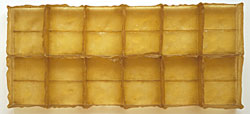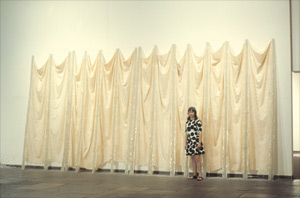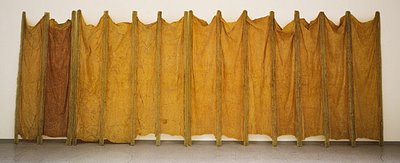.
New York is enjoying an extended minimal moment this fall. Although it’s been over half a century since reductive work made its first appearance, Minimalism’s "Greatest Hits" (and some current favorites) are playing all over town. Is there something in the ether that has provoked a spate of related shows at the same time? Or, as in fashion, is it simply a cycle whose time has come round again? Whatever the reason, there was and is a lot to see—and this is not an oxymoron.
Eve Hesse: Sculpture
Eva Hesse’s long-overdue retrospective, Eva Hesse: Sculpture, curated by Elizabeth Sussman and installed at the Jewish Museum this summer (May 12-September 17), seems to have been the catalyst.
.
 Installation of Eva Hesse: Sculpture at the Jewish Museum, New York City, May 12-September 17, 2006
Installation of Eva Hesse: Sculpture at the Jewish Museum, New York City, May 12-September 17, 2006
 Eva Hesse: Repetition Nineteen III, cast resin, 1968
Eva Hesse: Repetition Nineteen III, cast resin, 1968




 Eva Hesse: Contingent, 1969
Eva Hesse: Contingent, 1969


 While the work has aged, Hesse has not. She will always be pictured as a round-faced woman in her early 30s. The exhibition includes black-and-white--and voiceless--Super-8 footage from that time showing her working in her studio. Hesse never lived long enough to grow old. Born in 1936 in Hamburg, she died of a brain tumor in New York in 1970 at the age of 34. (It comes as of a shock to realize she would have been 70 this year.)
While the work has aged, Hesse has not. She will always be pictured as a round-faced woman in her early 30s. The exhibition includes black-and-white--and voiceless--Super-8 footage from that time showing her working in her studio. Hesse never lived long enough to grow old. Born in 1936 in Hamburg, she died of a brain tumor in New York in 1970 at the age of 34. (It comes as of a shock to realize she would have been 70 this year.)
The show is over, but the museum has produced a catalog, Eva Hesse: Sculpture, and there are a number of additional good books on the artist.
New York is enjoying an extended minimal moment this fall. Although it’s been over half a century since reductive work made its first appearance, Minimalism’s "Greatest Hits" (and some current favorites) are playing all over town. Is there something in the ether that has provoked a spate of related shows at the same time? Or, as in fashion, is it simply a cycle whose time has come round again? Whatever the reason, there was and is a lot to see—and this is not an oxymoron.
Eve Hesse: Sculpture
Eva Hesse’s long-overdue retrospective, Eva Hesse: Sculpture, curated by Elizabeth Sussman and installed at the Jewish Museum this summer (May 12-September 17), seems to have been the catalyst.
.
 Installation of Eva Hesse: Sculpture at the Jewish Museum, New York City, May 12-September 17, 2006
Installation of Eva Hesse: Sculpture at the Jewish Museum, New York City, May 12-September 17, 2006.
The Jewish Museum, located on Fifth Avenue’s Museum Mile, is a lovely turn-of-the-century structure that was once a private home, but it's no Whitney. The exhibition is installed in one large U-shaped gallery on the ground floor, with a low ceiling. Still, this was the institution that made a commitment to showing Hesse’s oeuvre after the Whitney backed out a few years ago. I was grateful to see this work in one place. As an art student I remember seeing Hesse’s work around town and periodically after that at MoMA until the work’s fragility required it to be archivally sequestered. Here, it’s everything I remember and more.
 Eva Hesse: Repetition Nineteen III, cast resin, 1968
Eva Hesse: Repetition Nineteen III, cast resin, 1968.
Hesse, as you well know, used non-beautiful materials—modest conventional stuff like twine and rope; industrial stuff like fiberglass; and at-the-time archivally untried stuff, like latex and resins—to effect her reductive and repetitive, and largely translucent, forms. Hesse’s great works are here: the 19 cast fiberglass vessels of Repetition Nineteen III (1968) in curatorially organized disarray; the protuberant grid of Schema (1967-1968); the multiple box-like segments of Sans II (1968); the stuffed latex and canvas panels of Aught (1968); the wall-like curtain of Expanded Expansion (1968); the latex-dipped sheets of Contingent (1969) and more. Since there was no photography in the gallery, I have pulled images from the Internet.
Hesse, as you well know, used non-beautiful materials—modest conventional stuff like twine and rope; industrial stuff like fiberglass; and at-the-time archivally untried stuff, like latex and resins—to effect her reductive and repetitive, and largely translucent, forms. Hesse’s great works are here: the 19 cast fiberglass vessels of Repetition Nineteen III (1968) in curatorially organized disarray; the protuberant grid of Schema (1967-1968); the multiple box-like segments of Sans II (1968); the stuffed latex and canvas panels of Aught (1968); the wall-like curtain of Expanded Expansion (1968); the latex-dipped sheets of Contingent (1969) and more. Since there was no photography in the gallery, I have pulled images from the Internet.

Eva Hesse: Aught, stuffed latex and canvas, 1968


Eva Hesse: Sans II, cast resin, shown in a segment, top, and in full installation, 1968; (segments have gone to various institutions and private collectors)

Eva Hesse: Schema, cast latex with movable elements,1967-1968. The hemispherical elements look as if they were cast from a handball. Their placement is ordered but not perfect, and each element rests unattached on the flat latex surface. This is a floor sculpture; you can see it in the tiny installation picture above
 Eva Hesse: Contingent, 1969
Eva Hesse: Contingent, 1969Perhaps because she intentionally left the trace of her process, including imperfect shapes and the impression of her own fingertips, her sculpture is as maximal as Minimalism can be—formally reductive but still resonating with Hesse-ian energy. Am I anthropomorphizing her work? Maybe. But her process—the dipping, casting, rolling, stitching, knotting, repeating; low-tech construction and the evidence of her hand—is so much a part of her work that it’s impossible not to “see” her still in the work.
An audio component allowed you to hear her as well, as it included fragments from interviews.
Many of her two dimensional works and some of her sculptures have a decided textile reference. Her four-part Aught--latex on the front, canvas on the back and stuffed with some kind of textural material--reads not only as sculpture but as blankets or quilts. The latex and fiberglass sheets in Contingent hang like, well, sheets, though Hesse herself said something like, "It’s really a painting hung in another material than a painting." Hesse worked early in her career as a textile designer, and that might account for the way she connected her particular dots—her use of thread, twine and rope; the sheets of latex--or it may be my own background (I am the granddaughter of tailors) that sees those connections.
One thing I can tell you for sure is that time has not been kind to the sculptures. Conceptually they are as strong as they always were, but structurally they are old before their time, the latex having become yellow and brittle with age. See the difference between Expanded Expansion when it was first made in 1968 and more recently. (The paintings and works on paper appear to have aged better.)
.
.

Hesse standing in front of Expanded Expansion in 1968 or sometime in the late 60s, above; a more recent shot of the work, which has yellowed (and become brittle) over time

 While the work has aged, Hesse has not. She will always be pictured as a round-faced woman in her early 30s. The exhibition includes black-and-white--and voiceless--Super-8 footage from that time showing her working in her studio. Hesse never lived long enough to grow old. Born in 1936 in Hamburg, she died of a brain tumor in New York in 1970 at the age of 34. (It comes as of a shock to realize she would have been 70 this year.)
While the work has aged, Hesse has not. She will always be pictured as a round-faced woman in her early 30s. The exhibition includes black-and-white--and voiceless--Super-8 footage from that time showing her working in her studio. Hesse never lived long enough to grow old. Born in 1936 in Hamburg, she died of a brain tumor in New York in 1970 at the age of 34. (It comes as of a shock to realize she would have been 70 this year.)The show is over, but the museum has produced a catalog, Eva Hesse: Sculpture, and there are a number of additional good books on the artist.
This post was adapted and edited slightly from New York's (Extended) Minimal Moment, posted November 24, 2006, on the collaboratiove blog I wrote with artist Chris Ashley, Two Artists Talking, now archived. In addition to reporting on "Eva Hesse: Sculpture," I talk about two gallery exhibitions--"Elemental Forms" at L&M Arts, and "Minimalism: On and Off Paper"-- and finished with "Brice Marden: A Retrospective of Paintings and Drawings" at the Museum of Modern Art.













No comments:
Post a Comment